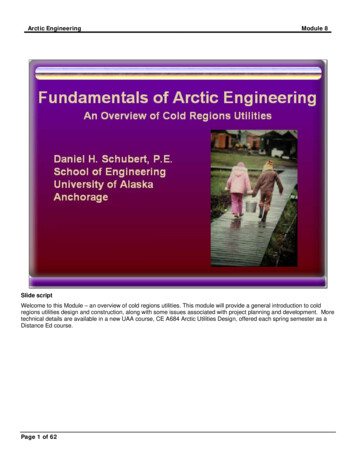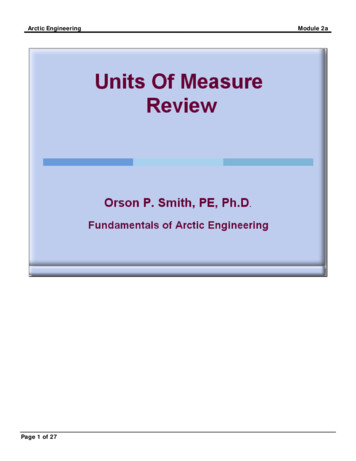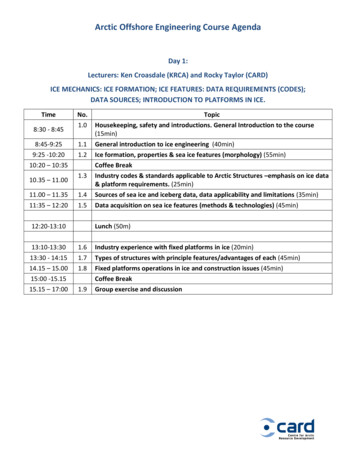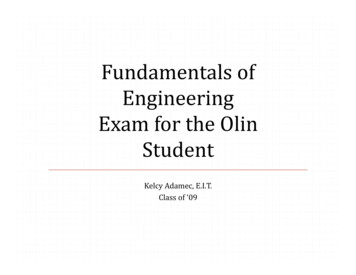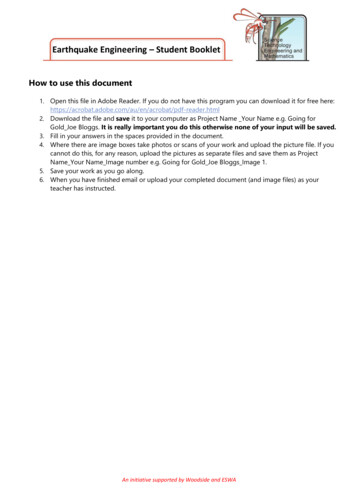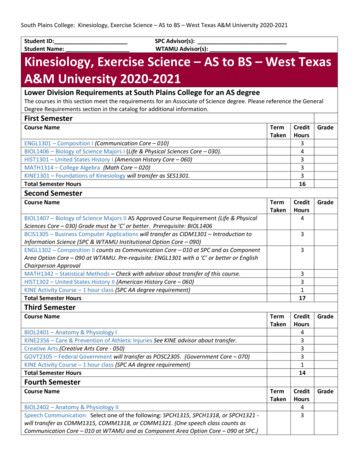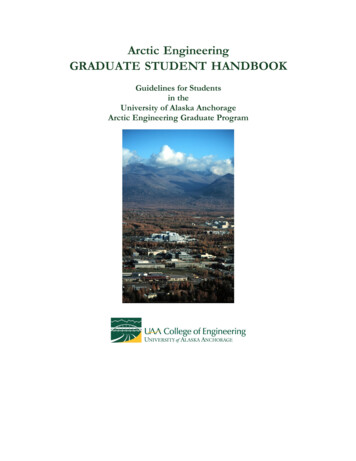
Transcription
Arctic EngineeringGRADUATE STUDENT HANDBOOKGuidelines for Studentsin theUniversity of Alaska AnchorageArctic Engineering Graduate Program
This page is intentionally blank
Arctic EngineeringGRADUATE STUDENT HANDBOOKGuidelines for Studentsin theUniversity of Alaska AnchorageArctic Engineering Graduate ProgramRevised 23 February 2015University of Alaska Anchorage, College of Engineering907-786-1900 http://www.uaa.alaska.edu/civilengineering/arctic/
This page is intentionally blank
Arctic EngineeringGRADUATE STUDENT HANDBOOKTABLE OF CONTENTSTopicWhy Study Arctic Engineering?Arctic Engineering at UAAAdmission to the Arctic Engineering Program at UAARegistration for ClassesUAA Graduate RequirementsMaster of Science in Arctic Engineering, Program RequirementsResearch Assistantships/Financial AidArctic Engineering FacultyArctic Engineering Project Report GuidelinesSample Title PageSample Title PagePage11223344456
This page is intentionally blank
ARCTIC ENGINEERINGGRADUATE STUDENT HANDBOOKGuidelines forArctic Engineering Graduate StudentsUniversity of Alaska AnchorageWhy Study Arctic Engineering?As our 21st century world turns to the north for mineral resources and global supply logistics, there is asustained demand for engineers, in both the commercial and public service sectors, who are trained tosolve problems in cold regions. UAA’s Arctic Engineering program provides a specialized curriculum toprepare professionals for: Development of cold regions’ natural resources,Multi-modal transportation improvements in cold regions,Design and operation of constructed works in rural communities and winter cities where snow,ice, and frozen ground constrain the efficacy of conventional methods, andEvaluation of climate change impacts on northern infrastructure.Climate models consistently show that Arctic regions of the world are the most sensitive to globalwarming. Recent scientific findings indicate that physical characteristics of Arctic atmosphere,ocean, and land have been changing since the 1970s. As a result, Arctic research has growingnational and global importance.UAA’s College of Engineering has responded to these trends with a series of new researchinitiatives aimed at evaluating and responding to climate change impacts on infrastructure in coldregions. UAA Arctic Engineering faculty members are leaders in national and international effortsto prepare northern civilizations for the changes of this millennium.Arctic Engineering at UAAThe Masters of Science in Arctic Engineering degree curriculum is designed to be delivered online toprovide graduate education for engineers who must deal with the unique challenges of design,construction, and operations in cold regions of the world. Special problems created by the climatic,geological and logistical conditions of the Arctic and sub-Arctic require knowledge and techniquesthat are rarely presented in conventional engineering courses. A thorough knowledge of heattransfer processes and properties of frozen ground and frozen water is basic to conducting mostengineering activities in the cold regions. The subject areas of hydraulics, hydrology, materials andutility operations are also uniquely impacted by Arctic considerations. The Arctic Engineeringprogram requires completion of a set of core courses which prepare engineers to understand andadapt prior engineering knowledge and skills to problems of cold regions. The program also allowsstudents to study advanced elective courses in a particular area of specialized interest. Researchactivities carried out by faculty of the UAA College of Engineering provide opportunities forproject reports utilizing current Arctic knowledge. A graduate Advisory Committee composed of atleast three members—of which the Chair and one other member must be UAA Arctic Engineeringfaculty—is appointed to guide each admitted student to degree completion. Additional programguidance is available via the URL referenced above.Upon successful completion of the program, students will have gained sufficient knowledge to:1. Recognize natural conditions and engineering challenges that are unique to cold regions;2. Interpret associated specialized language and units of measure;1
3.Locate, interpret, and apply public information about the physical conditions of coldregions;4. Apply fundamental physical principles to achieve solutions to common cold regionsengineering problems;5. Assess the need for complex specialized Arctic engineering solutions;6. Determine physical and thermal properties, evaluate frost heave rates, and estimate heatflow in soils; prevent foundation failure due to seasonally or perennially frozen ground byappropriate project site exploration and design of constructed features;7. Determine mathematical and physical properties governing heat and mass transfer in coldclimates;8. Determine temperature profiles in structure walls, roofs, and foundations; predict moisturecontent and mass flow rates in structures;9. Acquire, integrate, and interpret data from public archives regarding site conditionsassociated with planning and design of community utility systems and formulate fieldmeasurement programs to determine site conditions for planning and design;10. Analyze properties of lake, river, and sea ice; predict behavior of ice under naturalconditions, and predict ice forces on engineering structures; and11. Apply the sum of specialized Arctic engineering knowledge and skills gained in the programtoward solutions for practical engineering problems and report these to fellow specialists.Admission to the Arctic Engineering Program at UAAAll students admitted to the Arctic Engineering program must have previously earned abaccalaureate degree in an engineering discipline with a cumulative undergraduate GPA of at least3.00. Probationary admission may be granted by the Civil Engineering Department for studentswhose cumulative undergraduate GPA is between 2.50 and 3.00, but who have successfullycompleted graduate studies at the 3.00 level or better and have other evidence of their potential forsuccess in graduate engineering studies. Probationary terms will typically call for successfulcompletion of a pre-approved sequence of 9 credits of graduate engineering courses. Admittedstudents are also responsible for completion of prerequisites for Arctic engineering program courseswhich may not have been included in their undergraduate education.Applications for admission to UAA graduate programs are submitted online via: http://http://www.uaa.alaska.edu/admissions/.From admission through graduation, continuous registration is expected every fall and springsemester until all requirements for the degree are completed. To make continuous progress in theirgraduate program, students have the option of a) registering for at least one (1) graduate level creditapplicable to their graduate degree or b) paying the continuous registration fee to remain active inthe graduate program, even though not registered in any courses.Registration for ClassesStudents register for classes online via the UAOnline at https://uaonline.alaska.edu/. Onlineclasses are accessed via the UAA Blackboard system at: http://uaa.alaska.edu/classes.Graduate Studies Plan. The graduate studies plan (list of courses) is based upon catalogrequirements for the Arctic Engineering MS degree (see Program Requirements below). No formalplan is submitted to Graduate School for this program.Graduate Advisory Committee. A student’s Graduate Advisor typically acts as Chair of thatstudent’s Graduate Advisory Committee. The advisor and the student select a Graduate StudiesCommittee consisting of at least 3 members. Two (including the Chair) must be UAA College of2
Engineering full-time faculty members. One committee member may be from a discipline outsidethe College of Engineering and may be an Adjunct or Affiliate UAA Professor. Additionalmembers who are not UAA faculty, but have appropriate professional credentials, may be includedwith the approval of the Arctic Engineering program Chair, the committee chair, and the student.The graduate advisor and committee will:1. Approve elective courses.2. Review and approve the Arctic Engineering project, including the initial proposal.UAA Graduation RequirementsCandidates must submit an Application for Graduation to Enrollment Services, along with theapplication fee, no later than the published due date (see Academic Calendar athttp://www.uaa.alaska.edu/records/calendar/ ). Applications received after the deadline will beprocessed for the following semester.See the UAA Catalog for University Requirements for Graduate rams/degreerequirements/ ).Master of Science in Arctic Engineering, Program Requirements1.2.3.4.Candidates must complete the following core courses (9 credits):AE A603Arctic Engineering* (3 credits)AE A681Frozen Ground Engineering (3 credits)AE A685Arctic Heat and Mass Transfer (3 credits)*Students who have completed AE/CE A403 Arctic Engineering with a grade of C orbetter, or students who have passed the ES AC030 Fundamentals of Arctic Engineeringor ES AC031 Introduction to Arctic Engineering before being admitted to the programmust replace AE A603 with an elective, 3-credit course accepted by the student’s graduateadvisory committee.Candidates must also complete at least three additional courses from among the followingArctic engineering program elective courses (9 credits):AE A682Ice Engineering (3 credits)AE A683Arctic Hydrology and Hydraulic Engineering (3 credits)AE A684Arctic Utility Distribution (3 credits)AE A689Cold Regions Pavement Design (3 credits)To fulfill the minimum 30-credit degree requirement, candidates must complete additionalgraduate electives (9 credits) in mathematical, science or engineering subjects related to orsupportive of the student’s program of study, as approved by the student’s advisorycommittee. Provided a grade of B or better is achieved, one technical undergraduateelective course at the 400 level may be applied to this requirement with prior permissionof the student’s advisory committee. All coursework applied toward degree requirementsmust be approved by the student’s advisory committee.Each student must complete the following course (3 credits) after approval of a projectproposal by the student’s advisory committee:AE A698Arctic Engineering Project 3The Arctic Engineering project should have the following characteristics:a) The Arctic Engineering project must solve a practical engineering problem to theextent that original developments by the candidate are instrumental and evident in theproject report.b) The project problem and solution must be presented in the context of the currentstate-of- the-art by means of a thorough review of pertinent literature.c) The project must include innovative components directly involving cold regionsengineering.d) The project must have sufficient scope to clearly demonstrate the candidate’s3
advanced technical expertise in cold regions engineering.The project report must demonstrate command of knowledge and skills directlyassociated with the candidate’s graduate program of study.f) In the judgment of the candidate’s advisory committee, the written project reportmust be publishable in the proceedings of a cold regions engineering specialtyconference.g) The work must require a level of effort consistent with three semester hours of credit(approximately 45 to 60 hours per credit hour, or 135 to 180 hours total effort).h) UAA’s Graduate School requires a Project Submission Packet. raduate-school-projects.cfm fordetailed information.A total of 30 credits is required for the degree.e)5.Research Assistantships. Faculty and research staff of the College of Engineering may haveresearch grant support available for full time graduate students who are registered in 3 courses persemester, for assisting with laboratory or field measurements, data analysis, numerical simulations,and related aspects of academic research projects. The number and type of research projects variesfrom time to time. Informal inquiries to the Dean, Program Chairs, or individual faculty are the bestway to seek out and apply for research assistantships.Other financial aid. A variety financial aid programs, including college loans, are administeredthrough the UAA Student Financial Aid office. More information is available athttp://www.uaa.alaska.edu/financialaid/Arctic Engineering FacultyAaron Dotson, Assistant Professor, addotson@uaa.alaska.eduRobert Lang, Professor, rjlang@uaa.alaska.eduAndrew Metzger, Assistant Professor, atmetzger@alaska.eduTom Ravens, Professor, tmravens@uaa.alaska.eduOrson Smith, Professor Emeritus, opsmith@uaa.alaska.eduZhaohui Yang, Professor, zyang2@uaa.alaska.eduHannele Zubeck, Professor/Chair, hkzubeck@uaa.alaska.eduArctic Engineering Project Report GuidelinesThe Graduate Project Submission Package requires certain forms raduate-school-projects.cfm) and title andsignature pages. See full explanations at the aforementioned web page, and examples specific toArctic Engineering MS degree below. The Graduate School requires that you follow the formatrequired for your thesis as closely as possible s/index.cfm ).4
Sample Title and Signature PageTITLE PAGES MUST HAVE THE EXACTTITLE AS THE SIGNATURE PAGEAPROJECTPresented to the Facultyof the University of Alaska Anchoragein Partial Fulfillment of the Requirementsfor the Degree ofMASTER OF SCIENCE IN ARCTIC ENGINEERINGByWill Wheaten, B.S.Anchorage, AlaskaMay or December YEAR
SIGNATURE PAGE –AN EXAMPLE:SIGNATURE PAGES DO NOT HAVE PAGE NUMBERSByWill WheatonRECOMMENDED:Committee Member, Ph.D., P.E.Committee Member, Ph.D., P.E.Committee Chair, Ph.D., P.E.Chair, Advisory CommitteeProgram Chair, Ph.D., P.E.Chair, Arctic Engineering ProgramAPPROVED:Kenrick Mock, Ph.D.Associate Dean, College of EngineeringDate
or ES AC031 Introduction to Arctic Engineering before being admitted to the program must replace AE A603 with an elective, 3-credit course accepted by the student’s graduate advisory committee. 2. Candidates must also complete at least three additionalcourses from among the following
